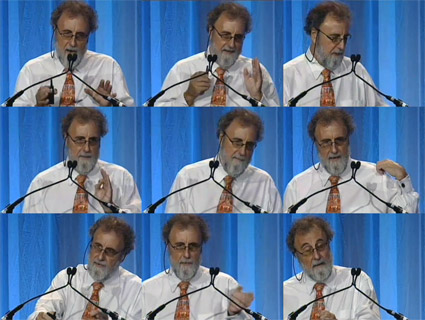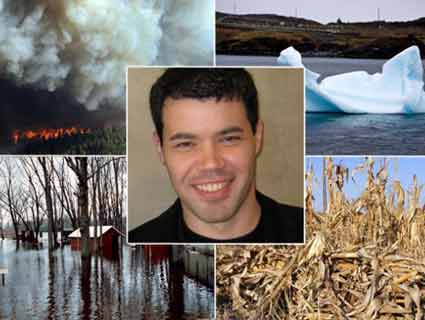“It’s good for us here, right now. But over time, it’s going to have catastrophic effects.”
The unseasonably warm December day—over 70 degrees in the DC area; the previous day had set a new temperature record—provided an apt backdrop for Massachusetts Rep. Ed Markey’s remarks, which drew detailed parallels between two separate “cliffs”—fiscal, and climatic. Coauthor of the Waxman-Markey bill, former head of the House Select Committee on Energy Independence and Global Warming, and currently ranking Democrat on the Natural Resources Committee, Markey had been writing energy legislation since before some members of his audience were breathing. And as he noted, Washington seems to have been heating up lately over what ultimately looks like by far the lesser of two disasters.
“If our country goes over the fiscal cliff,” Markey explained, “we will be able to climb back up. But if our planet goes over the climate cliff, we will plunge into an abyss of impacts that we cannot reverse.”
Markey was speaking at the third Climate Desk Live briefing, headlining a panel of experts convened to discuss concrete steps that can be taken in the next four years to do something about the ever-worsening climate problem. With the World Bank releasing a scientific horror story about a planet 4 degrees Celsius warmer by 2100, and news that global carbon emissions climbed a dramatic 3 percent last year, taking action is now moving beyond a matter of mere urgency—it’s a crisis, plain and simple.
“We don’t need to go over the climate cliff to know what that plunge would look like,” Markey continued, adding that “the last two years have been filled with scenes of the other side of the climate cliff that look like they were out of the disaster movie The Day After Tomorrow.”
Adding some levity, he noted, “The movie I’m talking about is not the movie Thelma and Louise.”
However, Markey’s speech was not unduly pessimistic. As he noted, while global emissions are rising, US emissions are actually going down—thanks to an array of actions by the states (especially California) and the Obama administration. Moreover, there is a vast deal that the president can do about climate change—even faced with a intransigent Congress. Really, it’s all about whether Obama wants to lead.
Presidential Climate Action Project head Bill Becker noted that the tools available to a president who really wants to get something done are pretty darn vast. “He’s the commander in chief and the CEO of 15 departments, 3 million civil employees, 1,300 agencies, and 2,600 programs,” said Becker, whose organization has made a study of presidential power with respect to climate and energy policymaking.
So what kinds of actions could Obama take? Much of the climate agenda today focuses not on cutting carbon, but on adaptation and resilience—because we are already being pummeled in a new era of disasters. And here, there’s a great deal the president can do. “There are clearly opportunities to engage with regard to adaptation, and to have Congress take action on disaster spending, to try and help communities rebound in a way that’s different and more resilient in the future,” explained Vicki Arroyo of the Georgetown Climate Center.
Among other actions, Arroyo called for reinvigorating the President’s Climate Change Task Force, and for the White House to release federal agency reports on climate vulnerability across the breadth of the government. “A dedicated full-time staff on the adaptation issue I think would be fabulous,” she added.
Much attention was also dedicated, notably, to the president’s recently lackluster rhetoric on climate change. Eric Pooley, author of The Climate War and a senior vice president at the Environmental Defense Fund, cited the example of how the president and White House press secretary Jay Carney recently dismissed any relationship between global warming and Hurricane Sandy. “Climate change didn’t cause Sandy, but it did make the storm stronger,” Pooley explained. “That is clear science linked to this specific storm, but the administration has not been—yet—very clear on that connection.”
Pooley, Markey, and the rest of the panel agreed on the single largest thing the president can do without needing Congress’s approval: direct the Environmental Protection Agency to toughly regulate emissions from coal-fired power plants, the single largest source of US greenhouse gases. According to a recent analysis by the Natural Resources Defense Council, tough action by EPA could cut these emissions by 26 percent by the year 2020.
But for those who care about climate action, perhaps the most resonant message of the day was that the Obama administration has to be pushed along, in significant part by those who can furnish evidence and arguments behind the case for the action—and maybe, more accurate talking points to boot. “We need to create a parade the president can jump in front of,” Becker said. “But he also needs to educate, and cultivate that support. That’s what leadership is.”











